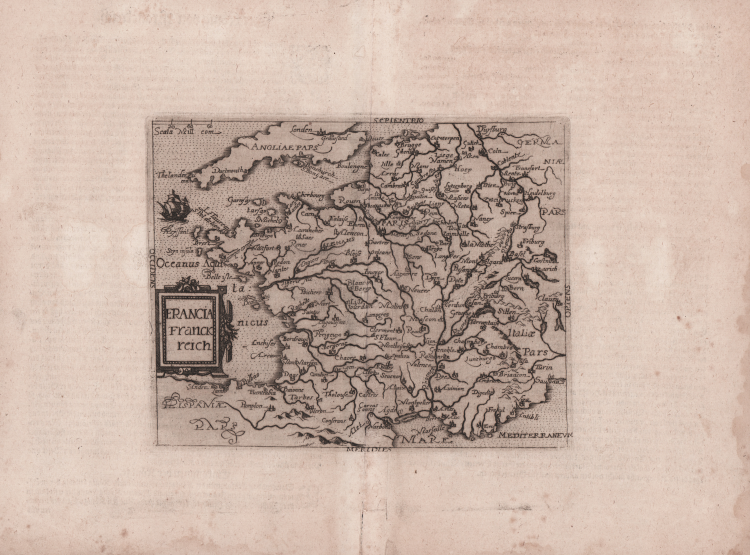



| Reference: | s26750 |
| Author | Giovanni BOTERO |
| Year: | 1597 |
| Zone: | France |
| Printed: | Cologne |
| Measures: | 190 x 153 mm |


| Reference: | s26750 |
| Author | Giovanni BOTERO |
| Year: | 1597 |
| Zone: | France |
| Printed: | Cologne |
| Measures: | 190 x 153 mm |
Map taken from the German edition of Giovanni Botero's works, called Theatrum oder Shawspiegel, edited in 1596 by Lambert Andreas, who also published the Latin text edition in the same year.
The work is part of the atlases edited by the so-called Cartographic School of Cologne, which lasted for about half a century (c. 1570-1620), and consisted mainly of Flemish and Dutch refugees, among them Matthaeus Quad himself and Frans Hogenberg, who was its founder.
The maps are attributed some to Jan Matal and others to Michael von Eitzing.
Cartographically, the maps are a derivation of and based on maps first published in Antwerp by Abraham Ortelius in 1570; the engravings of the maps, however, are attributed to Frans Hogenberg. The great rarity of the works contributes to the appeal of this important map, a cornerstone of every cartographic collection. Each collection turns out to be different from the other, as extensively documented in Peter H. Meurer's essay, Atlantes Colonienses, Die Kolner Schule der Atlaskartographie 1570-1610. Our example corresponds to the Atlas described as BOT 2.
Giovanni Botero (1544 - Turin 1617) was an Italian presbyter, writer and philosopher, author of Relazioni universali, a treatise on political geography first published in Rome in 1591 without cartographic illustrations. The work immediately became very important and an object of study throughout Europe, virtually beginning the study of demography.
Jan Matal or Metellus, French by birth and active in Louvaine and Cologne, where he took refuge precisely to escape persecution by the Catholic rulers and where he died in 1597. He was among the leading cartographers of the time and, along with Quad and Hogenberg himself, the leading exponent of the Cologne school. Some of Matal's maps are later included in later posthumous publications and bear the text on the verso.
Lambert Andreas (active between 1590 and 1598) was primarily an editor, however, some of the maps in his publications are attributed to him, albeit dubiously.
Cartographically, the maps are a derivation of maps first published in Antwerp by Abraham Ortelius in 1570.
Copperplate engraving, impressed on contemporary laid virgin paper, usual central crease, minor oxidation, otherwise in very good condition.
Bibliografia
Meurer, Atlantes Colonienses Die Kolner Schule der Atlas Kartographie 1570-1610, pp. 74/78, BOT 2; cfr. Ginsberg, Printed Maps of Scandinavia and the Arctic, pp.150/153, 35 & 36; cfr. Suarez, Early Mapping of Southeast Asia, pp. 186/7, 104; cfr. Burden, The Mapping of North America, p. 115, 90; cfr. Shirley, Early Printed Maps of the British Isles, p. 83, 189; cfr. Borri, L’Italia nelle antiche Carte, p. 95, 106; cfr. Walter, Japan a Cartographic Vision, 20; cfr. Tibbets, Arabia in Early Maps, p. 57, 50.
Giovanni BOTERO (Bene, od. Bene Vagienna, 1544 - Torino 1617).
|
Botero was sent to the Jesuit college in Palermo at the age of 15. In 1565, Botero was sent to teach philosophy and rhetoric at the Jesuit colleges in France, first in Billom, and then in Paris. He was discharged from the Jesuit order in 1580. After, he was commissioned by Bishop Carlo Borromeo of Milan as a personal assistant. When the Bishop died in 1584, Botero continued his service to the family as assistant to Carlo Borromeo's nephew, Federico. By the late 1580s, Botero had already published a few works, the his most famous: Della ragion di Stato (The Reason of State). Through the 1590s, Botero continued in the employ of Federico Borromeo, who would become Archbishop of Milan in 1595. Botero mixed in the high society of Rome and Milan in these years, and published another work for which he was to become quite well known, the Relazioni Universali. Released in four volumes between 1591 and 1598 (a fifth volume was finally published in the late nineteenth century), the 'relations' of the title referred to those of the 'universal' (Catholic) church in various parts of the world, a treatise on "The Strength of all the Powers of Europe and Asia", and even includes the Americas. The work marks the beginning of demographic studies.
|
Giovanni BOTERO (Bene, od. Bene Vagienna, 1544 - Torino 1617).
|
Botero was sent to the Jesuit college in Palermo at the age of 15. In 1565, Botero was sent to teach philosophy and rhetoric at the Jesuit colleges in France, first in Billom, and then in Paris. He was discharged from the Jesuit order in 1580. After, he was commissioned by Bishop Carlo Borromeo of Milan as a personal assistant. When the Bishop died in 1584, Botero continued his service to the family as assistant to Carlo Borromeo's nephew, Federico. By the late 1580s, Botero had already published a few works, the his most famous: Della ragion di Stato (The Reason of State). Through the 1590s, Botero continued in the employ of Federico Borromeo, who would become Archbishop of Milan in 1595. Botero mixed in the high society of Rome and Milan in these years, and published another work for which he was to become quite well known, the Relazioni Universali. Released in four volumes between 1591 and 1598 (a fifth volume was finally published in the late nineteenth century), the 'relations' of the title referred to those of the 'universal' (Catholic) church in various parts of the world, a treatise on "The Strength of all the Powers of Europe and Asia", and even includes the Americas. The work marks the beginning of demographic studies.
|